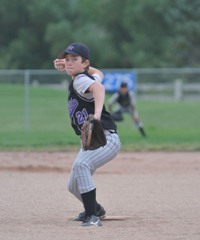Inadequate warm-up for relief pitchers is an often overlooked risk factor in youth baseball pitchers.
Consider the example of a centerfielder who, after playing in the outfield for 6 innings, is asked to switch positions and become a relief pitcher in the last inning and throw as hard as he can after seven - count 'em seven - warm up pitches.
When he misses location or leaves a ball right over the heart of the plate that says to the batter, "hit me!," he ends up shouldering the blame when it is actually the coach who should be held accountable for his poor performance, and for exposing him to possible arm injury for trying to throw so hard before his arm is loose.

Research by the American Sports Medicine Institute shows that an average pitcher needs to throw twenty-five fastballs before he achieves command and is fully warmed up. Twenty-five, not seven!
Coaches need to do a better job of anticipating the need for a relief pitcher by paying attention to the flow of the game and knowing how many pitches it takes for his pitchers to get loose and gain command before going into the game. Better that the pitcher takes his twenty-five warm up pitches on the sideline (as pitchers do at the college and pro level), rather than throwing seven warm-up pitches and eighteen more to live batters.








